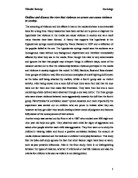Outline and discuss the view that violence on screen can cause violence in society.
Niloofar Bozorgi Sociology
Outline and discuss the view that violence on screen can cause violence in society.
The screening of violence and the effects it has on the media ahs been a controversial issue for a long time. Many researches have been carried out to prove or disprove the hypothesis that violence in the media can cause violence in society and as a result many theories have been formed. A theory that supports this hypothesis is the Hypodermic syringe model developed by Vance Packard in 1957 and a reflection of the popular belief at the era. The hypodermic syringe model sees the audience as a homogenous mass without any background experiences and therefore immediately affected by what they see in the media. Even though this view is very deterministic and ignores the fact that people may interpret things in different ways, some of the research carried out to find the relationship between violence portrayed in the media and violence in society supports this model. In 1963, Bandura, Ross and Ross showed three groups of children real, film and cartoon examples of a self righting doll known as the bobo doll being attacked by mallets, whilst a fourth group saw no violent activity. After being shown into a room full of toys there were then told that the toys were not for them and thus made feel frustrated. They were then led into a room containing a bobo doll and were observed through a one way mirror. The three groups who were shown violence behaved more aggressively towards the doll than the fourth group. Nevertheless the correlation doesn’t prove causation and more importantly the experiment was carried out on children who are prone to imitate what they see, however as they get older they would develop a better sense of judgment and become fully aware of the consequences of their actions.







